FEATURE
Labor of Love: Opening Up Archival Gems for Community Engagement
by Lora Baiocco
| Doklabís Local Stories and the multitouch table project have opened the archives and special collections of the library in new and engaging ways. |
Opened in 1899, the Westmount Public Library (WPL) in Quebec, Canada, is an architectural gem. First reactions to the space often include the word “beautiful.” And while the space reflects the time in which it was built—through architecture and decorative elements—it does not reflect the stories hiding in library archives, special collections, and reserve stacks.
The items with the strongest connections to the community—the unique items and documents that tell our local stories—are our least accessible. An extensive postcard collection—made possible by the generosity of Westmount citizens—contains more than a century of relationships, historical milestones, and social history. Our multitouch table project with Doklab’s Local Stories application puts local stories back into our public spaces, so people can engage with regional history in new ways.
The multitouch table project provides an opportunity to avoid an all-or-nothing situation in regard to digitizing special collections. We can now curate smaller, more manageable parts of the collection and make them available sooner. As a small team, we navigate copyright, scan what we need, and highlight the stories of interest to our community.
The Table: Nuts, Bolts, and Touchpoints
The WPL, in collaboration with the city of Westmount’s IT department, recently purchased Doklab’s Local Stories (doklab.nl/en/project/local-stories) application and a multitouch table. Julie-Anne Cardella, the library director, saw the application in action on a library tour of the Netherlands. Doklab, based in Delft, has created an application that makes it easy for libraries and other cultural institutions to tell their own stories. The WPL’s digital content has become accessible and interactive. Working with Erik Boekesteijn, Jaap van de Geer, and the rest of the Doklab team, Local Stories is coming to Westmount in two languages (French and English) at the beginning of summer 2016. Using it is the simplest part of the project. Working in the cloud, we are able to upload images, videos, and text, as well as create quizzes and populate maps with points of interest. Most of the functionality is as easy as attaching a document to an email.
The table was put together by Hadrien Laporte of SmartPixel.tv, a local provider of solutions for large-format and mobile touchscreens. SmartPixel worked with a local carpenter to design a wood table that matched the older decor of the library. It was fitted with a mini computer, a 46" LED display, an infrared (IR) multitouch overlay (with 12 touchpoints), an audio divider, and inputs for four sets of headphones.
The Collection That Inspired the Collaboration
The inspiration behind the collaboration with Doklab came from the WPL Postcard Collection. The collection includes more than 40,000 postcards, most of them donated by the citizens of Westmount. The cards in the collection span 130-plus years. The earliest postcard dates back to 1878. How did a single branch library, serving a population of 20,000 citizens, amass such a collection? The short answer is generosity. In 1974, to celebrate the 75th anniversary of the library and the city’s centennial, the library board’s chairman, the library director, and the city council decided to build a postcard collection. They began with only 11 cards.
The 1974 team put out a call in the local newspaper (Westmount Examiner; “Library Launches a Collection of Postcards”): “The Westmount Public Library is going to collect postcards. It is asking citizens to scour their attics, old correspondence, albums and other likely caches for contributions to the collection. … [I]t [postcard collecting] is increasingly being recognized as an excellent means of historical record and a way to preserve for posterity, more clearly sometimes than the written word, the story of contemporary times.” The goals today—to unearth the treasures of historical and social importance in and for the community—remain the same.
As part of the call to donate, the team created a postcard; it depicted the library and was sent to every home along with its electric bill. The back of the card was used to solicit donations: “The Centennial Postcard Collection is growing by leaps and bounds. Please give the Westmount Library your old postcards.”
Citizens gave then, and they continue to give today. The postcards are currently organized by geographic regions (based on the images) and special topics (holidays, trains, and libraries, etc.). The province of Quebec—the focus of the original collection—is subdivided into towns, cities, or villages. Access to the collection, prior to the implementation of the multitouch table, was limited to flipping through black and white photocopies housed in large binders behind the reference desk. The binders contain copies of the first 13,000 Quebec-themed cards the library received. The binders also come with rules, understandably motivated by preservation, about how the public can access—and whose permission is needed for—a glimpse of the colorized cards.
The rest of the collection (27,000-plus postcards)—representing international destinations—was kept in boxes in filing cabinets. We are sorting and classifying this part of the collection—a project started with the help of volunteers, Emily and Elizabeth Cameron, more than 4 years ago. In the sorting process, we are flagging cards of particular interest that tell a story or share a theme, as well as ones that are visually interesting. We are scanning certain subsets on a flatbed scanner (EPSON Perfection V700 Photo) for use on either our Flickr account (flickr.com/bibliowestmount) or for future use on the multitouch table.
The Team and the Tales
Working with librarians Julie Bouchard and Daniel Miguez de Luca, we examine postcards and archival materials to create stories from within our collections. On the table, every touchpoint is important. We try to delight our users with every interaction, hoping that they will be compelled to keep touching the table and moving through the story.
To create stories, we do the following:
- Identify themes and stories within the collection
- Storyboard our ideas
- Scan images, documents, or postcards using a flatbed scanner
- Research historical facts to enrich our stories and contextualize information
- Transcribe and translate handwritten messages
- Create interactive quizzes
- Plot points of interest on interactive maps
- Upload content through the Local Stories application
As a small staff in a single-branch system, we have been able to make this project possible while still managing our other roles and responsibilities. Content creation is the most time-consuming step in this project, but it is not beyond the reach of a small team that shares a passion for local history.
Conclusion
We are currently working on stories about the history of the city of Westmount and the history of the WPL. The launch will take place when three full stories are on the table in both English and French. The team is also looking forward to local anniversaries (the Olympics) and working on identifying local organizations for future collaborations.
Doklab’s Local Stories and the multitouch table project have opened the archives and special collections of the library in new and engaging ways. The table will be placed in a high-traffic area where conversation will be encouraged. With more than a century of stories to draw from, Local Stories and the multitouch table will marry the old and new for all visitors to enjoy.
|
Sabourin: Our First Story
One of the richest stories comes from a subset of our postcard collection. The Sabourin Collection is a love story told through a romantic exchange between Alida Dubeau and Ernest Sabourin. From their courtship to their marriage, the collection contains more than 500 cards written from 1906 to 1909—during the heyday of postcards. It also contains 300-plus cards from other suitors, friends, and family. Having both sides of an extended correspondence makes the collection quite rare. The content—both the graphics and the written correspondence—tells rich stories that we can illustrate easily with the multitouch table and the Local Stories application.
Doklab’s Local Stories and the multitouch table gave us the space to display the story in ways that would otherwise be difficult or time-consuming for the researcher. To extract the story, told in their own words, we transcribed (French text) and translated (into English) the pivotal or historically interesting messages on the backs of the cards. Through our extended study of the collection, we were able to decipher the often messy handwriting.
Once we could read about the intrigues, Local Stories provided a forum for us to present the facts in ways best-suited to the content. In addition to the scanned images, we could extract quotes that moved the story along. Dubeau, for example, had other suitors. Through cards sent to her from those suitors, and through comments and teasing from her cousin’s cards, a picture of the romantic life and courting traditions of the day emerges.
Dubeau’s cousin is part of a larger cast of more than 50 individuals we have been able to identify through the text and handwriting on the cards.
Seeing the Unseen
Many of the cards in this collection have fragile elements, including lace, dried flowers, feathers, and human hair. This project grants access to cards in the collection that are otherwise housed in archival sleeves and boxes. Even on-site researchers examining the originals would be using gloves and looking at them through transparent sleeves. On the table, they can enlarge the views to enhance details that might otherwise go unnoticed.
In another sense, the unseen is visible only when juxtaposed precisely. The card titled, “le Langage du Timbre,” cracked a secret code wide open: This card decodes the positioning of a stamp on a postcard. With so little space for heartfelt outpourings, even the stamps could convey meaning. Sabourin’s favorite messages were, “I send you my heart” (à toimon Coeur) and “I’m dying for your love” (je meurs pour ton amour). This card allows the viewer to examine the collection in a new way. Each card on the table contains a secret code.
Dubeau and Sabourin were married in 1909 (much to the chagrin of her other suitors). The postcards stopped, but the story lives on more than a century later through Local Stories and the multitouch table. Dubeau and Sabourin’s story is only the first.
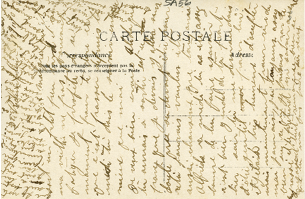 |
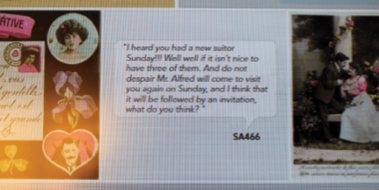 |
Ernest Sabourin’s barely legible handwriting
before transcription and translation |
Extracted from a postcard,
Alida Dubeau is teased by
her cousin. |
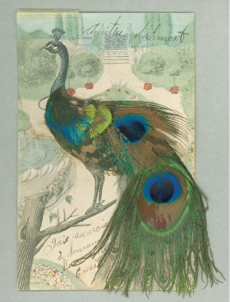 |
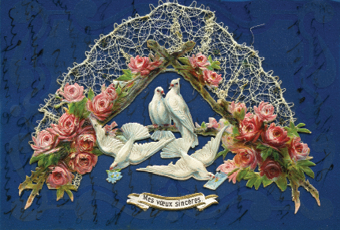 |
| Postcard with real feathers |
Celluloid postcard with lace |
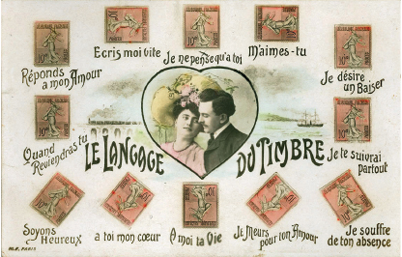 |
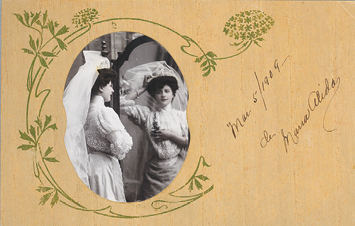 |
| Postcard depicting love messages through stamp placement |
The couple’s wedding day,
written on the front of the card |
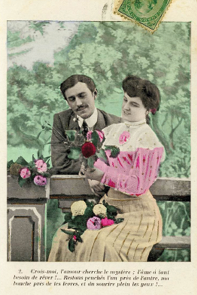 |
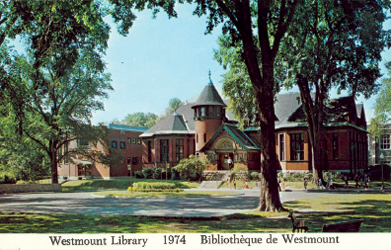
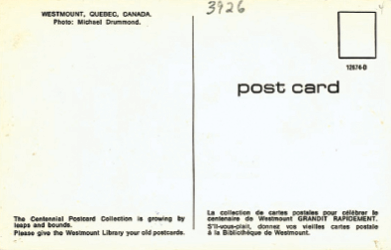 |
| The stamp placement means,
“I’m dying for your love.”
|
|
| Author and staff interacting with multitouch table. |
Postcard of the library in 1974,
including the call to citizens to donate their postcards |
|